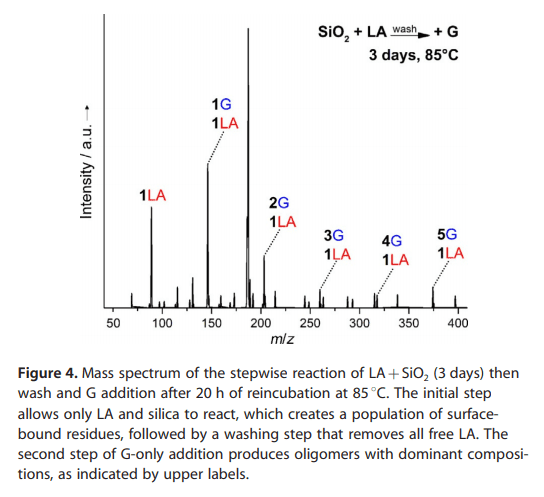Peptide Growth on Surfaces
 The organized polymerization of bio-monomers (i.e., amino acids, nucleic acids) to form their respective bio-polymers (i.e., proteins, RNA and DNA) is thermodynamically unfavorable in aqueous solution due to a required loss of water as well as increased order. Our biological systems have overcome this issue by coupling the endergonic formation of complex biomolecules to exergonic reactions such as the de-phosphorylation of ATP to ADP, which would have been difficult to achieve prior to the existence of complex, membrane-bound biochemical systems.
The organized polymerization of bio-monomers (i.e., amino acids, nucleic acids) to form their respective bio-polymers (i.e., proteins, RNA and DNA) is thermodynamically unfavorable in aqueous solution due to a required loss of water as well as increased order. Our biological systems have overcome this issue by coupling the endergonic formation of complex biomolecules to exergonic reactions such as the de-phosphorylation of ATP to ADP, which would have been difficult to achieve prior to the existence of complex, membrane-bound biochemical systems.
One way nature may have circumvented this problem on prebiotic Earth is by using surfaces to catalyze or promote ordered polymerization reactions. Surfaces can oftentimes aid in overcoming reaction barriers via binding molecules to empty orbitals, orienting molecules into favorable geometries, and facilitating energy transfer. In this work, we are investigating how a variety of minerals present in meteorites affect the formation of peptide bonds in aqueous mixtures of amino acids and lactic acid. Samples are heated in hydrothermal reactors in an oven, and products are analyzed via LCMS.
Read more:
A. D. McKee, M. Solano, A. Saydjari, C. J. Bennett, N. V. Hud, T. M. Orlando, “A possible path to prebiotic peptides involving silica and hydroxy acid-mediated amide bond formation”, ChemBioChem 10.1002/cbic.201800217 (2018). Link
